The exosome-based skincare market has been valued at USD 852.3 million in 2025 and is projected to advance to USD 3,952.7 million by 2035. This progression reflects an absolute increase of USD 3,100.4 million over the decade, translating into a robust CAGR of 16.6%. Such expansion signals the acceleration of science-driven skincare and the transition toward biologically active formulations.
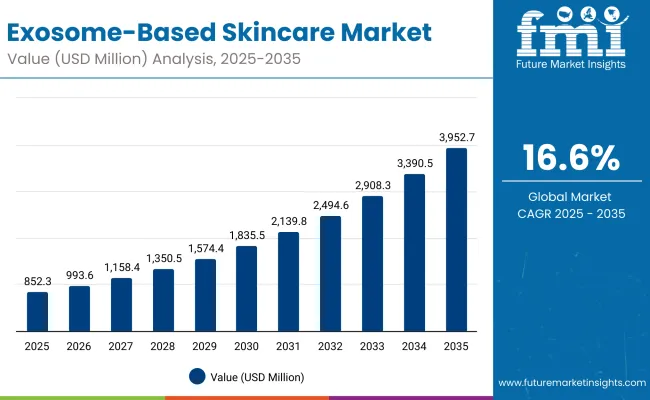
Exosome-Based Skincare Market Key Takeaways
| Metric | Value |
|---|---|
| Market Estimated Value In (2025E) | USD 852.3 Million |
| Market Forecast Value In (2035F) | USD 3,952.7 Million |
| Forecast CAGR (2025 to 2035) | 16.60% |
During the first phase of growth, from 2025 to 2030, the market is forecast to expand from USD 852.3 million to USD 1,835.5 million. This period adds nearly USD 983.2 million, which accounts for around one-third of the decade’s total value creation. Growth is expected to be steady, led by greater adoption of regenerative skincare solutions, early commercialization of exosome-derived actives, and rising investments in clinical validation. Professional channels, including dermatology and aesthetics clinics, are anticipated to hold a strong position as trusted points of introduction, ensuring sustained consumer awareness and confidence.
The second half of the forecast horizon, from 2030 to 2035, is projected to witness an accelerated growth trajectory, with market value climbing from USD 1,835.5 million to USD 3,952.7 million. This period alone will contribute nearly USD 2,117.2 million, which equals more than two-thirds of total decade expansion. Acceleration is expected to be supported by broader consumer acceptance, deeper penetration into direct-to-consumer retail, and the scaling of synthetic and engineered exosome technologies that ensure consistency, purity, and cost efficiency.
Overall, the exosome-based skincare industry is positioned as one of the fastest-growing categories in advanced cosmeceuticals, benefiting from the convergence of biotechnology, consumer demand for effective anti-aging solutions, and expanding global distribution networks.
From 2020 to 2024, the market transition toward exosome-derived solutions was shaped by biotech innovation and dermatology integration, paving the way for clinical skincare adoption. Between 2025 and 2035, significant expansion is projected, with clinical-grade exosome serums and regenerative treatments becoming mainstream. Competitive advantage is expected to shift from traditional cosmetic claims toward science-backed formulations, AI-driven personalization, and subscription-based treatment models, as players emphasize ecosystem-driven strategies for sustained growth.
Growth in the exosome-based skincare market is being driven by multiple converging factors that highlight its strong future trajectory. A rising demand for advanced anti-aging and regenerative solutions has been observed, as consumers increasingly prioritize scientifically validated formulations over conventional cosmetics. The ability of exosomes to stimulate cellular communication and repair processes has been positioned as a breakthrough in achieving visible, long-lasting results, which is expected to fuel adoption.
Clinical validation and professional endorsements are also accelerating growth, with dermatology and aesthetics clinics incorporating exosome-based products into treatment protocols. As consumer trust is influenced by clinical efficacy, this channel has created a robust foundation for wider retail and e-commerce penetration. Additionally, advances in biotechnology and scalable manufacturing have improved product stability, purity, and consistency, reducing barriers to commercialization.
Future expansion is expected to be reinforced by rising investment in engineered exosomes that deliver targeted benefits, coupled with increasing regulatory clarity that supports compliant market entry across regions. This alignment of science, consumer demand, and commercialization capability is ensuring sustained growth momentum.
The exosome-based skincare market has been segmented across multiple dimensions to capture the diversity of demand drivers. By function, the market reflects strong consumer interest in anti-aging and regenerative solutions, underpinned by growing awareness of scientifically validated skincare benefits. By channel, distribution remains anchored in clinics and professional outlets, where clinical endorsement enhances credibility, while consumer-facing routes continue to gain momentum.
By product type, formats such as serums have achieved strong acceptance due to their compatibility with daily regimens, while broader product categories complement their use across multiple skin concerns. Together, these segments illustrate how the market’s trajectory is being shaped by scientific innovation, distribution dynamics, and consumer adoption patterns that reinforce exosome-based actives as a transformative category.
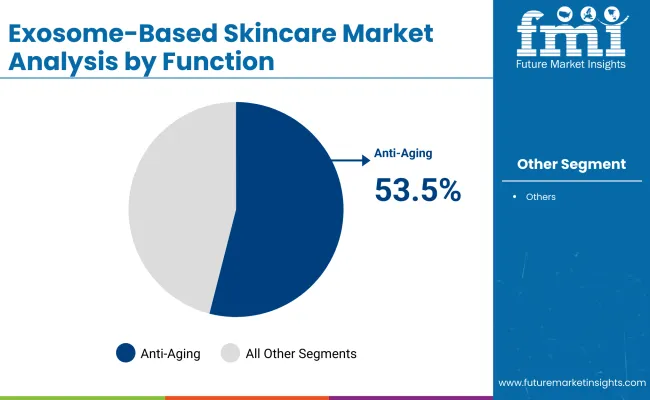
| Segment | Market Value Share, 2025 |
|---|---|
| Anti-aging | 53.50% |
| Others | 46.50% |
The function segment is expected to be dominated by anti-aging applications,53.5% of value in 2025, equal to USD 455.6 million. Growth has been driven by rising consumer emphasis on long-term skin health and proven regenerative benefits, with exosomes positioned as advanced actives delivering cellular repair and improved dermal vitality. The ability to stimulate rejuvenation at a cellular level is anticipated to reinforce demand in both professional and consumer markets. Other functions such as hydration, repair, and whitening are expected to play complementary roles, yet anti-aging is projected to retain its dominance given its direct link to premium skincare adoption.
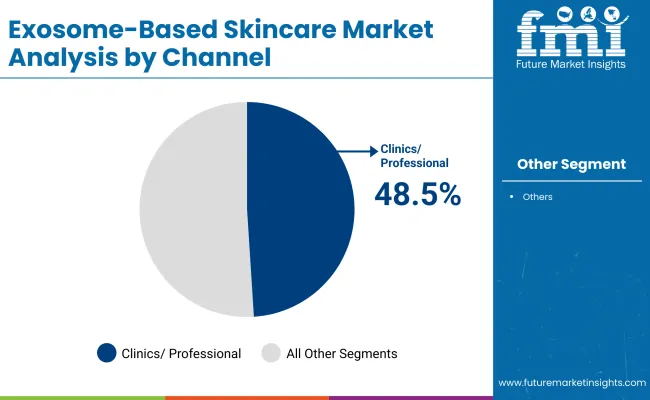
| Segment | Market Value Share, 2025 |
|---|---|
| Clinics/professional | 48.50% |
| Others | 51.50% |
Distribution has been led by clinics and professional outlets, representing 48.5% of 2025 market value at USD 412.1 million. Professional settings have acted as trust anchors, where exosome-based skincare is introduced within dermatology and aesthetic treatments. Clinical endorsements have validated performance claims, building consumer confidence and encouraging repeat usage. While other channels, including specialty retail and online platforms, hold a slightly higher share of 51.5%, clinics are expected to remain critical in educating consumers and driving premium positioning. Over time, professional credibility is projected to enable downstream adoption across wider distribution networks, reinforcing clinics as the foundation of market expansion.
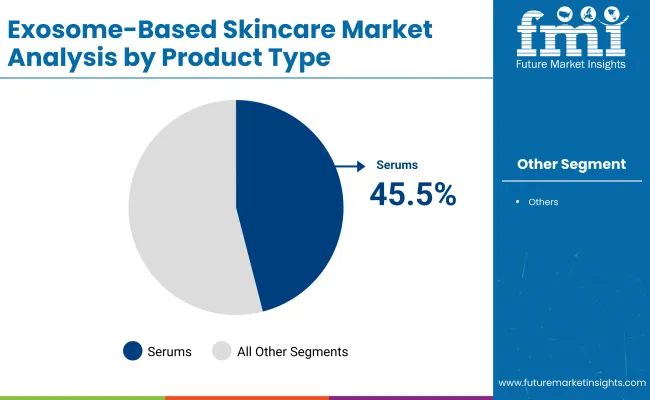
| Segment | Market Value Share, 2025 |
|---|---|
| Serums | 45.50% |
| Others | 54.50% |
and accurate measurements by calculating the geometry of scanned objects based on laser light Within product types, serums have emerged as a significant category, contributing 45.5% of value in 2025, equivalent to USD 386.9 million. Their high compatibility with daily skincare routines, fast absorption, and ability to deliver concentrated actives have established them as a preferred format. Serums have also gained traction across clinics and e-commerce due to their portability and regimen versatility. Other product types collectively accounted for a slightly larger share at 54.5%, reflecting the market’s diversity across creams, patches, and injectables. Nonetheless, serums are projected to remain a growth catalyst, supported by their alignment with consumer trends favoring targeted, science-backed formulations with visible results.
The exosome-based skincare market is advancing through a mix of scientific innovation, clinical acceptance, and consumer adoption. However, regulatory uncertainty, manufacturing complexities, and evolving consumer expectations are shaping both opportunities and challenges across its future growth trajectory.
Integration of Engineered Exosomes for Precision Skincare
The introduction of synthetic and engineered exosomes is being positioned as a transformative driver for market expansion. Unlike traditional plant- or stem cell-derived exosomes, engineered variants offer reproducibility, batch consistency, and targeted delivery of bioactive molecules. This precision is expected to enhance therapeutic relevance, reduce variability, and improve scalability.
Companies leveraging genetic engineering and advanced isolation techniques are anticipated to achieve stronger clinical validation, thereby enabling partnerships with global cosmetics and dermatology brands. Over the forecast horizon, the capability of engineered exosomes to deliver tailored benefits, such as targeted anti-inflammatory or collagen-stimulating effects, is projected to redefine competitive differentiation and accelerate commercialization in both professional and retail channels.
Regulatory Ambiguity Across Global Markets
The absence of harmonized regulatory frameworks for exosome-based skincare products is being recognized as a significant restraint. In many jurisdictions, exosomes exist in a gray area between cosmetics and biologics, leading to uncertainty in approval processes and permissible claims. This ambiguity complicates cross-border commercialization, delays product launches, and increases compliance costs.
Inconsistencies in classification standards across the US, EU, and Asian markets may further limit scalability for smaller firms with limited regulatory capacity. As scrutiny over safety, source ethics, and clinical claims intensifies, companies without robust governance structures may face heightened risk of recalls, litigation, or reputational damage. Until clearer guidelines are established, this regulatory volatility is expected to act as a critical constraint on global expansion.
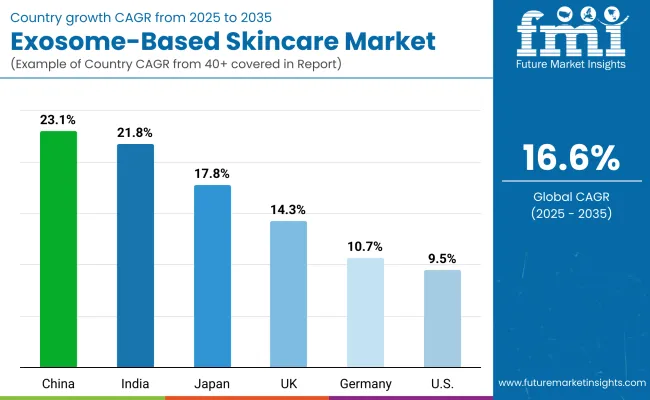
| Countries | CAGR |
|---|---|
| China | 23.1% |
| USA | 9.5% |
| India | 21.8% |
| UK | 14.3% |
| Germany | 10.7% |
| Japan | 17.8% |
The exosome-based skincare market demonstrates significant variation in growth potential across leading countries, shaped by consumer readiness, clinical adoption, and regulatory alignment. Asia-Pacific is emerging as the fastest-growing region, with China projected to record a CAGR of 23.1% and India closely following at 21.8% during 2025-2035. In China, strong investment in medical aesthetics, rising consumer preference for science-driven skincare, and a high penetration of professional clinics are expected to anchor its leadership. India’s expansion is anticipated to be powered by growing middle-class affordability, increasing dermatology clinic density, and heightened awareness of anti-aging solutions among younger demographics.
Japan’s market is forecast to grow at 17.8%, supported by advanced biotechnology capabilities, early regulatory frameworks for cosmeceuticals, and a cultural emphasis on anti-aging and skin health. Europe’s outlook remains resilient, with Germany at 10.7% CAGR and the UK at 14.3%, reflecting robust integration of exosome products into dermatology clinics and cosmeceutical innovation pipelines. Stringent compliance requirements and a preference for clinically validated skincare are expected to sustain adoption in these markets.
The United States, despite being a mature skincare market, is projected to grow at a more moderate CAGR of 9.5%. Growth is expected to be driven by increasing use of exosome-based serums in premium dermatology practices and expanding consumer awareness, though regulatory caution may temper rapid expansion.
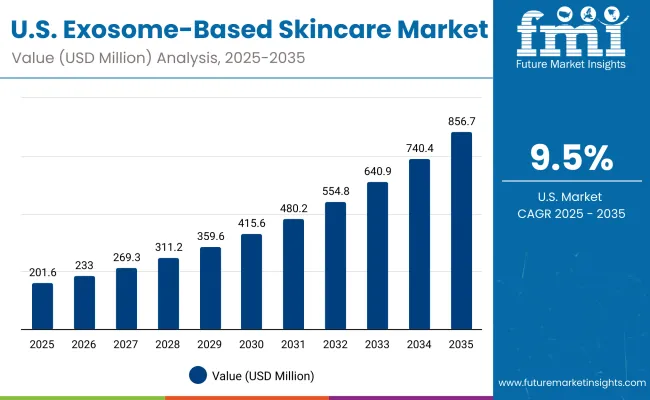
| Year | USA Exosome-Based Skincare Market (USD Million) |
|---|---|
| 2025 | 201.65 |
| 2026 | 233.04 |
| 2027 | 269.31 |
| 2028 | 311.22 |
| 2029 | 359.66 |
| 2030 | 415.61 |
| 2031 | 480.23 |
| 2032 | 554.85 |
| 2033 | 640.99 |
| 2034 | 740.41 |
| 2035 | 856.73 |
The exosome-based skincare market in the United States is projected to grow at a CAGR of 15.5% between 2025 and 2035, increasing from USD 201.65 million in 2025 to USD 856.73 million by 2035. Growth is expected to be sustained by the integration of exosome-derived actives into clinical dermatology and aesthetics practices, where patient trust in evidence-based formulations is high. Increased availability of exosome-based serums and injectables in professional settings is anticipated to accelerate mainstream adoption, while e-commerce and specialty retail are projected to broaden consumer access.
Market momentum is expected to be reinforced by collaborations between biotechnology developers and established skincare brands, enabling products with higher purity and clinical validation. Regulatory caution may temper the pace of approvals, but growing consumer preference for regenerative, anti-aging, and repair-focused products is likely to offset such barriers. The USA market’s relatively mature structure positions it to lead in innovation-driven adoption rather than volume-led growth, making it a critical hub for technology transfer, clinical trials, and product diversification.
The exosome-based skincare market in the United Kingdom is projected to grow at a CAGR of 14.3% from 2025 to 2035, reflecting strong adoption within premium clinical aesthetics and cosmeceutical channels. Expansion is expected to be anchored in dermatology practices and medical spas, where patient trust in science-backed skincare products remains high. Increasing consumer demand for anti-aging solutions and repair-focused formulations is expected to sustain premium pricing across both clinics and retail.
Market adoption is also being supported by the UK’s robust regulatory environment, which places emphasis on safety and clinical validation, thereby reinforcing consumer confidence. Growth opportunities are likely to emerge from e-commerce distribution and strategic collaborations between UK-based dermatology clinics and global biotech firms. By the end of the decade, the UK is positioned to be a leading European hub for innovation-driven adoption rather than volume-led growth.
The exosome-based skincare market in India is forecast to expand at a CAGR of 21.8% during 2025-2035, making it one of the fastest-growing global markets. Growth is expected to be underpinned by rapid urbanization, a rising middle-class population, and increasing consumer focus on advanced dermatological treatments. Dermatology and aesthetics clinics are expected to play a pivotal role in early adoption, particularly in metro and tier-1 cities, while e-commerce platforms are anticipated to extend accessibility across wider geographies.
The affordability of regenerative skincare is gradually improving as domestic clinics integrate exosome-based formulations into anti-aging and repair-focused treatments. Partnerships between international biotech firms and Indian cosmeceutical companies are expected to accelerate product introductions at competitive price points. India’s trajectory positions it as a high-potential market where volume-driven growth will combine with rising demand for premium outcomes.
The exosome-based skincare market in China is projected to grow at a CAGR of 23.1% between 2025 and 2035, establishing the country as the fastest-growing market worldwide. Clinics and professional aesthetics centers are expected to account for the majority of adoption, with a value share of more than 50% observed in the base year. Rising consumer willingness to invest in advanced anti-aging and repair solutions is anticipated to sustain premium growth.
Domestic biotech companies are rapidly scaling production capabilities, while collaborations with international skincare leaders are likely to bring new formulations with higher clinical validation. Regulatory developments aimed at cosmeceutical standardization are expected to support long-term adoption, particularly as safety and efficacy concerns are addressed. With a large, youth-driven consumer base and strong demand for visible results, China is projected to remain the epicenter of global market expansion.
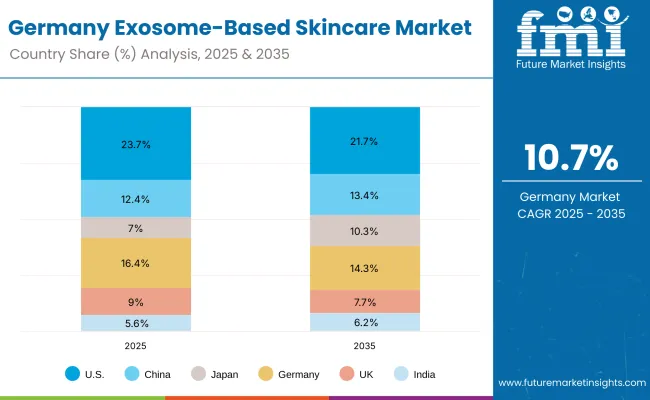
| Countries | 2025 |
|---|---|
| USA | 23.7% |
| China | 12.4% |
| Japan | 7.0% |
| Germany | 16.4% |
| UK | 9.0% |
| India | 5.6% |
| Countries | 2035 |
|---|---|
| USA | 21.7% |
| China | 13.4% |
| Japan | 10.3% |
| Germany | 14.3% |
| UK | 7.7% |
| India | 6.2% |
The exosome-based skincare market in Germany is expected to grow at a CAGR of 10.7% from 2025 to 2035, reflecting moderate but steady expansion. Growth is anticipated to be driven by integration of exosome formulations into clinical dermatology practices and the broader cosmeceutical sector. Germany’s strong emphasis on scientific validation, safety compliance, and consumer health awareness is expected to reinforce trust in exosome-based products.
Market adoption is projected to remain concentrated in anti-aging and skin repair applications, which align closely with consumer demand for science-backed efficacy. Specialty retail and e-commerce are also expected to expand product access, complementing clinics as the leading distribution channels. Despite slower adoption compared to Asian markets, Germany’s mature dermatology ecosystem and stringent regulatory standards are expected to make it a benchmark for clinical credibility and product safety within Europe.

| Segment | Market Value Share, 2025 |
|---|---|
| Anti-aging | 55.5% |
| Others | 44.5% |
The exosome skincare market in the USA is projected at USD 201.7 million in 2025. Anti-aging functions contribute 55.5% (USD 112.0 million), while other functions such as hydration, repair, and whitening collectively hold 44.5% (USD 89.66 million). Demand has been reinforced by a growing consumer focus on clinically validated, regenerative solutions that promise long-term skin vitality. The anti-aging segment has been propelled by rising interest in cellular rejuvenation, driven by dermatology professionals and premium skincare brands positioning exosomes as next-generation actives.
The segment’s growth is expected to be amplified by increased adoption of professional-grade treatments in medspas and dermatology clinics, paired with consumer-facing serums and creams that offer measurable results. Other functional categories are projected to support overall growth as complementary benefits, yet anti-aging is expected to remain the dominant driver due to its direct correlation with premium product adoption and higher willingness to pay.
Greater R&D investment in exosome purification technologies, partnerships between biotech innovators and skincare brands, and regulatory clarity from the FDA are likely to accelerate market maturity. As awareness rises, integrated solutions combining anti-aging, hydration, and repair benefits are anticipated to shape future product launches, creating a strong value proposition for both professional and at-home users.
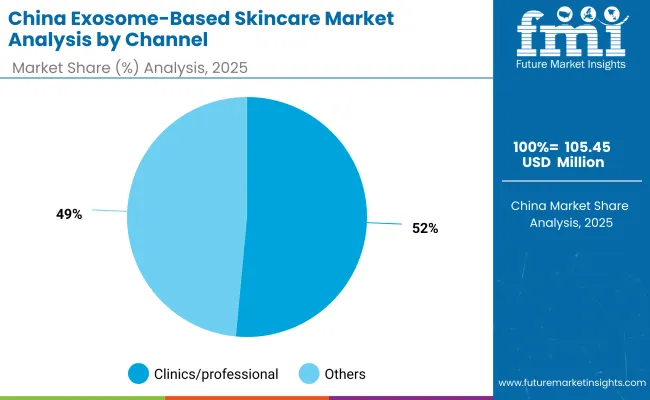
| Segment | Market Value Share, 2025 |
|---|---|
| Clinics/professional | 51.5% |
| Others | 48.5% |
The exosome skincare market in China is projected at USD 105.45 million in 2025. Clinics and professional channels are anticipated to contribute 51.5% (USD 54.3 million), while other channels collectively hold 48.5% (USD 51.15 million). Growth is being driven by the strong uptake of professional-grade exosome treatments in dermatology clinics, aesthetic centers, and medical spas, where trust in clinically validated solutions has been prioritized by Chinese consumers.
Professional channels are expected to dominate as awareness of exosome-based regenerative therapies grows, supported by a rising preference for scientifically backed, procedure-oriented solutions. This channel is forecasted to benefit from enhanced collaborations between biotech innovators and aesthetic practitioners, enabling wider accessibility and adoption.
The “others” segment, comprising retail and direct-to-consumer sales, is projected to act as a complementary growth pillar as exosome formulations transition into mainstream skincare offerings. Digital channels and social commerce are expected to accelerate product penetration, making exosome-based solutions more accessible to younger demographics seeking preventive anti-aging regimens.
Future growth is likely to be reinforced by increased investment in localized manufacturing and regulatory clarity from Chinese authorities, which will build consumer confidence. As hybrid models that combine in-clinic treatments with at-home maintenance kits emerge, the market is anticipated to transition toward an ecosystem-driven approach that maximizes long-term consumer engagement and repeat purchase behavior.
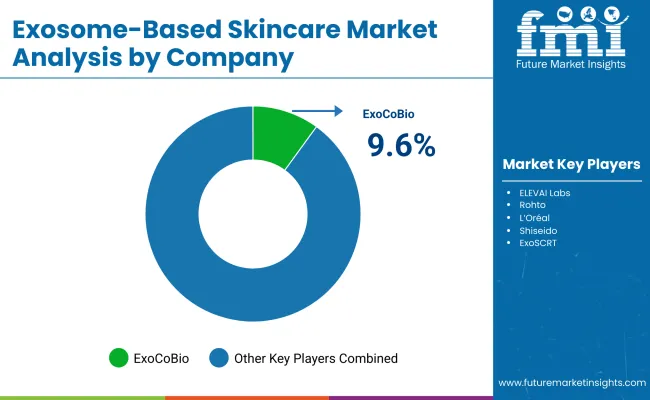
The Exosome-Based Skincare Market is moderately fragmented, with global leaders, mid-sized innovators, and specialized biotechnology players competing for adoption across clinical, retail, and professional segments. Leading players such as ExoCoBio, L’Oréal, and Shiseido dominate visibility owing to their established R&D, global reach, and strong investment in regenerative skincare solutions. Their strategies increasingly emphasize advanced exosome isolation, clinical validation, and integration of AI-driven personalization platforms. In 2024, ExoCoBio emerged as the market leader, holding approximately 9.6% of the global market share, a position supported by its strong clinical collaborations and its leadership in K-beauty innovation.
Established mid-sized innovators, including ELEVAI Labs, Rohto, and ExoSCRT, are strengthening their positions through targeted product launches and partnerships with dermatology clinics. Their focus on functional cosmetics and clinical-grade solutions enables penetration in both Asian and Western markets. Aesthetics Biomedical, CosmoDerm, and MediTox are further reinforcing competitiveness by aligning exosome science with personalized treatments and medical aesthetics, leveraging evidence-backed formulations.
Niche-focused players such as Cellexus are developing scalable bioprocessing systems for exosome production, contributing indirectly to the ecosystem by improving supply consistency and lowering costs. Competitive differentiation in this market is shifting away from pure product claims toward platform-based ecosystems involving diagnostic integration, clinic training, and subscription-driven skincare regimens.
Key Developments in Exosome-Based Skincare Market
| Item | Value |
|---|---|
| Market Size (2025) | USD 852.3 Million |
| Market Size (2035) | USD 3,952.7 Million |
| CAGR (2025-2035) | 16.60% |
| Function Segments | Anti-aging (USD 455.6 Million, 53.5%), Others (USD 396.0 Million, 46.5%) |
| Channel Segments | Clinics/Professional (USD 412.1 Million, 48.5%), Others (USD 439.1 Million, 51.5%) |
| Product Type Segments | Serums (USD 386.9 Million, 45.5%), Others (USD 464.9 Million, 54.5%) |
| Regions Covered | North America, Europe, Asia-Pacific, Latin America, Middle East & Africa |
| Countries Covered | United States, China, Japan, India, Germany, United Kingdom, South Korea, Brazil |
| Key Companies Profiled | ExoCoBio, ELEVAI Labs, Rohto, L’Oréal, Shiseido, ExoSCRT, Aesthetics Biomedical, Cellexus, CosmoDerm, MediTox |
| Additional Attributes | Rising adoption in anti-aging and regenerative skincare, high demand from clinics, integration of AI-driven personalization, expanding K-beauty exports, increasing biotech investments, and regulatory frameworks supporting cosmeceutical innovation. |
The global Exosome-Based Skincare Market is estimated to be valued at USD 852.3 million in 2025.
The market size for the Exosome-Based Skincare Market is projected to reach USD 3,952.7 million by 2035.
The Exosome-Based Skincare Market is expected to grow at a CAGR of 16.6% between 2025 and 2035.
The key product types in the Exosome-Based Skincare Market are Serums (45.5% share, USD 386.9 Million) and Other formulations (54.5% share, USD 464.9 Million).
In terms of channel, Clinics/Professional outlets are projected to command 48.5% share (USD 412.1 Million) of the market in 2025.






Full Research Suite comprises of:
Market outlook & trends analysis
Interviews & case studies
Strategic recommendations
Vendor profiles & capabilities analysis
5-year forecasts
8 regions and 60+ country-level data splits
Market segment data splits
12 months of continuous data updates
DELIVERED AS:
PDF EXCEL ONLINE
Skincare Supplement Market Size and Share Forecast Outlook 2025 to 2035
Skincare Oil Market Size and Share Forecast Outlook 2025 to 2035
Skincare Nutritional Serum Market Size and Share Forecast Outlook 2025 to 2035
Skincare Products Market Size and Share Forecast Outlook 2025 to 2035
Skincare Market Analysis - Size, Share, and Forecast Outlook 2025 to 2035
Skincare Packaging Market Size, Share & Forecast 2025 to 2035
Skincare Industry in India – Trends & Growth Forecast 2024-2034
Global Skincare Treatment Market Analysis – Size, Share & Forecast 2024-2034
Global PDRN Skincare Market Size and Share Forecast Outlook 2025 to 2035
Men’s Skincare Products Market Size, Growth, and Forecast for 2025 to 2035
Global Smart Skincare Market Size and Share Forecast Outlook 2025 to 2035
Cooling Skincare Gels Market Size and Share Forecast Outlook 2025 to 2035
Natural Skincare Preservatives Market Analysis - Size and Share Forecast Outlook 2025 to 2035
Ormedic Skincare Market Demand & Insights 2024-2034
Ceramide Skincare Market Size and Share Forecast Outlook 2025 to 2035
BPA-Free Skincare Market Trends – Demand & Forecast 2024-2034
Camellia Skincare & Cosmetics Market
Buffering Skincare Products Market Analysis - Size and Share Forecast Outlook 2025 to 2035
Menopause Skincare Solutions Market Size and Share Forecast Outlook 2025 to 2035
Probiotic Skincare Ingredients Market Size and Share Forecast Outlook 2025 to 2035

Thank you!
You will receive an email from our Business Development Manager. Please be sure to check your SPAM/JUNK folder too.
Chat With
MaRIA